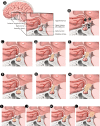An update on multimodal management of craniopharyngioma in children
- PMID: 37213301
- PMCID: PMC10196165
- DOI: 10.3389/fonc.2023.1149428
An update on multimodal management of craniopharyngioma in children
Abstract
Craniopharyngioma (CP) represent 1.2-4.6% of all intracranial tumors in children and carry a significant morbidity due to their lesional intimacy with structures involved in neurological, visual, and endocrinological functions. Variable treatment modalities being available, including surgery, radiation therapy, alternative surgeries, and intracystic therapies or combinations of them, their common goal is to reduce immediate and long-term morbidity while preserving these functions. Multiple attempts have been made to re-evaluate surgical and irradiation strategies in order to optimize their complication and morbidity profile. However, despite significant advances in "function sparing" approaches, such as limited surgery and improved technologies of radiation therapies, achieving interdisciplinary consensus on the optimal treatment algorithm remains a challenge. Furthermore, there remains a significant span of improvement given the number of specialties involved as well as the complex and chronic nature of CP disease. This perspective article aims to summarize recent changes and knowledge gains in the field of pediatric CP, outlining updated treatment recommendations, a concept of integrative interdisciplinary care and the implication of novel potential diagnostic tools. A comprehensive update on the multimodal treatment of pediatric CP is presented, focusing on "function-preserving" therapies and their implications.
Keywords: craniopharyngioma (CP); diagnosis; function preservation; multimodal management; pediatric; update.
Copyright © 2023 Lohkamp, Kasper, Pousa and Bartels.
Conflict of interest statement
The authors declare that this manuscript was composed in the absence of any commercial or financial relationships that could be construed as a potential conflict of interest.
Figures


References
-
- Olsson DS, Andersson E, Bryngelsson IL, Nilsson AG, Johannsson G. Excess mortality and morbidity in patients with craniopharyngioma, especially in patients with childhood onset: a population-based study in Sweden. J Clin Endocrinol Metab (2015) 100(2):467–74. doi: 10.1210/jc.2014-3525 - DOI - PubMed
LinkOut - more resources
Full Text Sources
Miscellaneous

